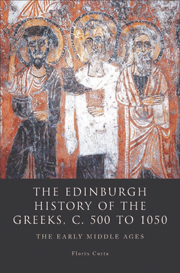Book contents
- Frontmatter
- Contents
- List of Illustrations
- List of Tables
- Acknowledgements
- Series Editor's Preface
- Introduction
- 1 The last century of Roman power (c. 500 to c. 620): army, church, and countryside
- 2 Collapse or adaptation? The problem of the urban decline in late antique Greece
- 3 Invasion or inflation? Hoards and barbarians in sixth- and early seventh-century Greece
- 4 Dark-Age Greece (c. 620 to c. 800)
- 5 Revival and expansion (c. 800 to c. 900)
- 6 The beginning of prosperity (c. 900 to c. 1050)
- 7 Early medieval Greece and the Middle Byzantine economy
- 8 Social structures and Byzantine administration in early medieval Greece
- 9 Christianity in early medieval Greece
- 10 Conclusion: the people of early medieval Greece
- Bibliography
- Index
9 - Christianity in early medieval Greece
Published online by Cambridge University Press: 05 August 2013
- Frontmatter
- Contents
- List of Illustrations
- List of Tables
- Acknowledgements
- Series Editor's Preface
- Introduction
- 1 The last century of Roman power (c. 500 to c. 620): army, church, and countryside
- 2 Collapse or adaptation? The problem of the urban decline in late antique Greece
- 3 Invasion or inflation? Hoards and barbarians in sixth- and early seventh-century Greece
- 4 Dark-Age Greece (c. 620 to c. 800)
- 5 Revival and expansion (c. 800 to c. 900)
- 6 The beginning of prosperity (c. 900 to c. 1050)
- 7 Early medieval Greece and the Middle Byzantine economy
- 8 Social structures and Byzantine administration in early medieval Greece
- 9 Christianity in early medieval Greece
- 10 Conclusion: the people of early medieval Greece
- Bibliography
- Index
Summary
Judging by the extant and distribution of the network of bishoprics, sixth-century Greece must have been a thoroughly Christianised province of the Empire. By 550 there were fifty-seven episcopal sees in Greece, with the large concentration in the province of Achaia (Zeiller 1926: 225). Bishops had a wide variety of ecclesiastical and civilian powers and the large number of churches in existence or built during the sixth century illustrates the ubiquity and considerable influence of the church in the life of the inhabitants of the provinces of Achaia, Epirus Vetus, Thessaly, Macedonia Prima, and Rhodope during the last century of Roman power (see Chapter 1). The highest-ranking man of the church in sixth century Greece was the archbishop of Thessalonica, but his influence over the Achaian, Thessalian, Macedonian, and Epirote bishops had diminished considerably by 550, primarily because of the Monophysite archbishop Dorotheos and the opposition he faced from the bishops of the Dacian and Macedonian dioceses. The bishops of Epirus Vetus and Thessaly turned to Rome, soon followed by their colleagues in other sees in Greece. However, such developments had no immediate consequences, primarily because of the accelerated regionalisation of the church organisation after c. 600 and the subsequent abandonment of the provinces in the southern Balkans by the Roman army and administration, whose presence was maintained only on a few key coastal points. During the subsequent centuries, several other archbishops of Thessalonica espoused non-Orthodox beliefs.
- Type
- Chapter
- Information
- The Edinburgh History of the Greeks, c. 500 to 1050The Early Middle Ages, pp. 249 - 275Publisher: Edinburgh University PressPrint publication year: 2011



